NGS Middle Schoolers Build Bridges, Experience Engineering During EOH Design Contest
March 23, 2017
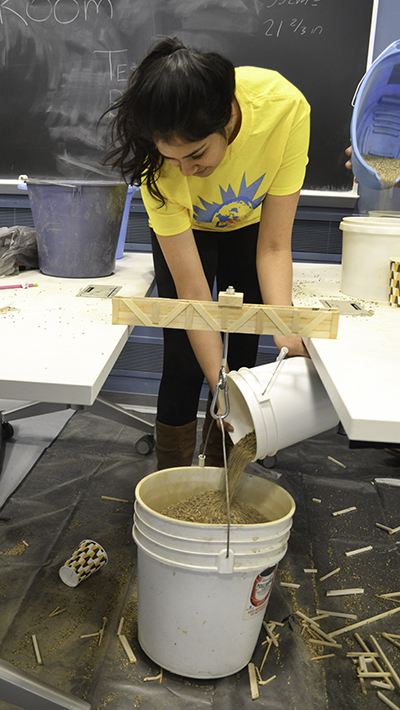
An Illinois engineering student helping with the EOH Middle School Design Project pours sand into a bucket to test the strength of the Big Papa team's bridge.
It had all come down to this. It was crunch time—figuratively, and possibly literally, if the bridge built as part of the Engineering Open House (EOH) Middle School Design Contest collapsed while being tested. For weeks, three teams of middle school students from Next Generation School (NGS) in Champaign had been designing bridges—building their prototypes, testing them, working out any kinks. Finally, Saturday, March 11th, the day of the contest, had arrived. With their fingers crossed, each team eagerly watched Illinois engineering students attach a bucket to their bridge then slowly fill it with sand. The idea was to see how much sand could be added before their bridge buckled. And whether they won an award or not, they’d learned a lot: about teamwork; about the engineering process; and what being a Civil Engineer might be like.
The rules of the contest run by Illinois engineering student Alix Ramos and her team of students were pretty specific. The bridge was to be built of wood: either balsa (lightweight, cheaper, but weaker) or bass (stronger, but heavier and more expensive) and adhesive. It was to span an opening of 40 cm, weigh less than 70 grams, and have a 3/8 in. hole for an eyebolt. Along with bridge specifications, descriptions of several truss designs were included in the contest packet to get students’ juices flowing. Testing would involve attaching a bucket to the eyebolt and adding sand until the bridge either broke or bent more than 2 cm.
When designing their bridges, students could target one or more of the award categories, which included:
- Most Innovative
- Lightest Bridge (must be capable of lifting a minimum weight TBA)
- Most Aesthetic
- Viewer’s Choice
- Lifts the Most Weight Overall
- Best Presentation
- Best Weight Lifted to Weight of Bridge Ratio
- Enthusiasm Award
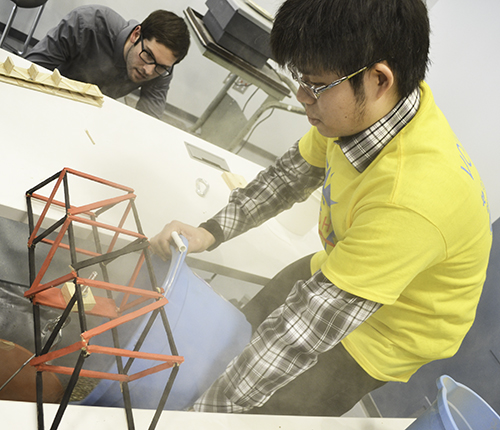
Fritz watches (upper left) as an Illinois Engineering student pours sand into a bucket to test the strength of the Blazers' bridge.
According to Bryant Fritz, who teaches Middle School Science at NGS, one of the challenges his students encountered in doing this project was understanding the rules of the contest.
“I think the first challenge was just being very clear with the constraints that they were given,” he says. “They had a lot of questions on whether they could or could not do something. I sent some messages to the contest organizers to make sure they had everything straight.”
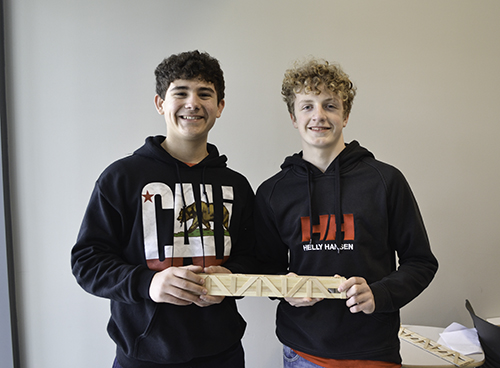
NGS' Big Papa team: Alexander Comet and Miles Wood, with their very sturdy bridge.
Before beginning their design, teams had to research what makes the strongest bridge. In this area, Fritz’s teams might have had a slight head start compared to other teams, because several weeks before the EOH contest, his teams had used the bridges as their project for their school’s science fair, which Fritz says involved doing background research:
“So they looked up different types of bridge designs, and they learned why they might be used, and what their different applications were. So from that research, they started to formulate their first prototype ideas.” He adds that throughout the process, his teams had experimented with using just balsa or just bass wood, or using both to reduce the weight.
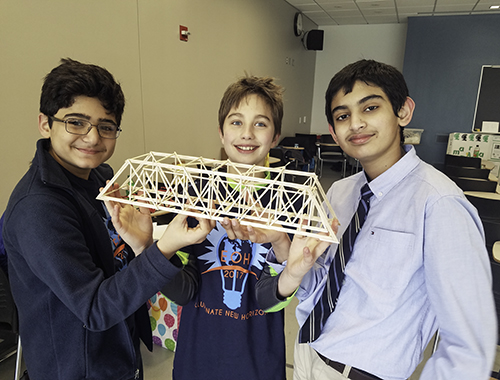
Above (left to right): A team of Next Generation School sixth graders, Navid Tajkhorshid, Noah Lanave, Hozaifa Bhutta, with the bridge they designed. (Photo courtesy of Bryant Fritz.).
Below: Noah Lanave and Navid Tajkhorshid watch as the eyebolt is attached to their bridge.
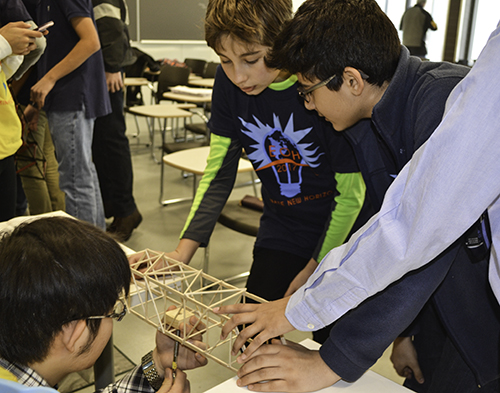
Fritz describes another challenge they encountered. When going through the design process, his students would discover a weakness in their bridge, or a change they needed to make. This cropped up when testing their bridges initially.
“When they were building the prototype, and breaking them.” Fritz explains, “They tested several of them in my room, and they realized that was a constraint, because each prototype takes time to build, because you have to cut each individual piece. So they made as many as they could, and that’s something I know was challenging for several of them.”
While it might have been challenging, through the ups and downs, they’d learned the engineering process: designing, building, testing, then going back to the drawing board to improve their design.
And according to Alix Ramos, an Illinois Sophomore in Computer Engineering who was in charge of the Middle School Design Contest, that’s why she took the project on—so students would not only engage with Engineering at Illinois, but would learn some engineering skills…and maybe discover that they loved engineering.
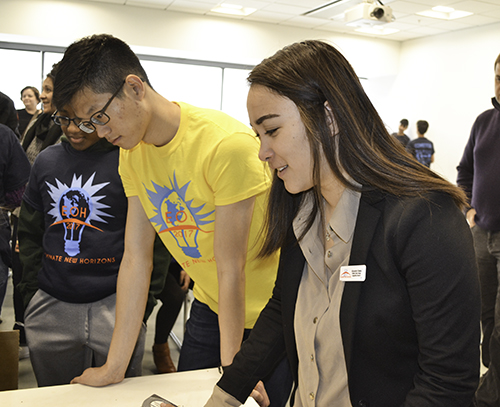
Alix Ramos (right) and another Illinois Engineering student watch as a bridge is tested.
“I really just wanted to have an opportunity to have kids engaged with EOH. And when they come in for the competition, we also give them time to go out and wander around. And also the fact that this is a competition where they can work on engineering skills like design, and critical thinking, and building. It's a really great way to start early and learn what they like and don’t like, and start to branch out. I really like how it engages younger children and exposes them to engineering."
Fritz reports that his students also grew a lot through the exercise: “I think just the whole process of solving a problem from the very beginning with all the frustrations and challenges when things don’t work the way you want them to, I think that’s a very valuable experience,” he acknowledges. “And then having the satisfaction of finishing it, and to see today how their work will do in the performance stage is very exciting for them.”
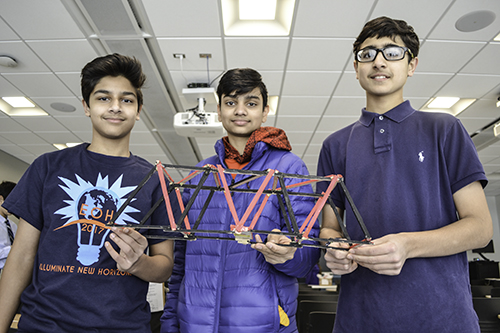
The Blazers team, Tabeeb Khandaker, Abhinav Sattiraju, and Hadi Ahmad exhibit the bridge they designed.
Since building bridges is Civil Engineering, did Fritz see any future Civil Engineers among his students? He saw several. And one student he might have kept his eye on was Hadi Ahmad. It makes sense that Hadi got involved in the bridge-building project—after all, his grandfather was a civil engineer who built a lot of bridges. Does Hadi think he’ll follow in his grandfather’s footsteps and become a civil engineer himself?
“Something like that,” he admits. He also acknowledges that his grandfather, who’s retired now, would like that. “Yes, he is encouraging me towards civil engineering, somewhat,” he says.
Fritz admits that having a student involved in the contest whose grandfather actually built bridges was pretty special. “It’s really neat that he’s potentially following in his footsteps by doing an activity like this.”
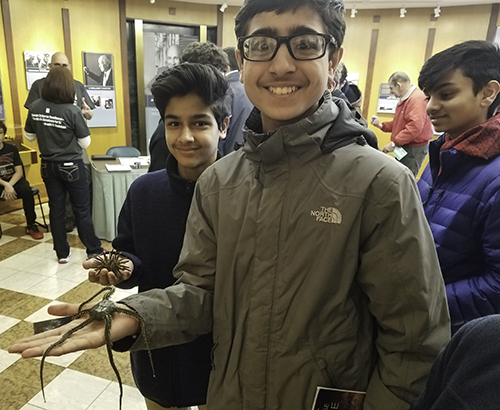
Left to right: NGS students Tabeeb Khandaker, Hadi Ahmad, and Abhinav Sattiraju, enjoying the Beckman Open house exhibits (photo courtesy of Bryant Fritz).
And should Hadi consider a career in the field down the road, he learned some things about building bridges while doing the project. For one thing, becoming a civil engineer who specializes in bridges—like Granddad—would probably mean job security.
“I learned that there are many bridges in America that are quite old and in dire need of maintenance,” he explains. Something else he learned related to bridge-building? “That one small issue in the building can lead to a large impact and total the whole thing.”
Hadi’s team, The Blazers, ran into one such issue while working on their project. Both he and teammate Tabeeb Khandaker agreed that one challenge was “making the joints of the bridge,” says Tabeeb. “Because it wouldn’t be clean all the time.” But luckily, they were able to pick the brain of one of the community experts at the science fair: “A judge at our science fair gave us a few tips,” admits Tabeeb.
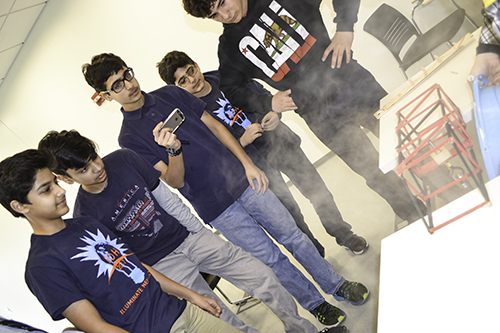
The Blazers team and some of their classmates watch as sand is being poured in to test their bridge.
Their third teammate, Abhinav Sattiraju, who also thinks he might be a civil engineer down the road, but definitely wants to do something involving mathematics, explains why he wanted to get involved with this project.
“Well, we thought it was really fun and interesting how bridges work in real life. And we wanted to try making a model bridge. And we’ve seen a bunch of other contests where you can build and the applications you can have for these things. It’s cool and fun to work with your friend, building bridges and cutting pieces out. His take on the contest, “This project was a lot of fun!”
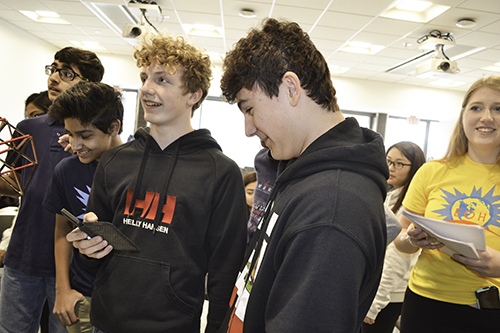
The Big Papa team (center) watches as their bridge is successfully holding a great deal of weight during testing.
Another of Fritz’ teams, Big Papa (Alexander Comet, Miles Wood, and a third teammate who was unable to be there) built a bridge that was a whopping 68 grams (just 2 grams shy of the weight limit). And not only did it weigh a lot, it could carry its own weight when tested. Even the Illinois engineering students testing it were amazed at the amount of weight the bridge held. The two report, "We were just trying to make our bridge strong." They succeeded.
While Alexander doesn’t think he’ll do Civil engineering (“I like sports. I’ll keep it in mind though!”), teammate Miles thinks he might. “Maybe,” he says. “I’ve always enjoyed building and designing things. I’m on a Lego robotics thing, and since I was a little kid, I’ve liked to design and build things.”

Members of the Blazers (center) and the Big Papa (far left and far right) teams show off their awards. (Photo courtesy of Bryant Fritz.)
How’d the students do? The Blazers (Hadi Ahmad, Tabeeb Khandaker, and Abhinav Sattiraju), ended up winning 1st place for the Viewer's Choice award! The Big Papa team, Alexander Comet and Miles Wood, had the leading bridge weight for a while (58.8 lbs), but got passed at the end. But they did take 2nd place for the Viewer's Choice Award.
Does Fritz think any of them will do the contest again next year? Yep.
“I’ve already had some of them asking what the contest would be next year, as we were walking around EOH,” Fritz admits. “And they already said they will be interested. So I think we will be back again. I had a lot of fun. And they all had a great day.”
Story & photographs by Elizabeth Innes, Webmaster, I-STEM Education Initiative.
More: Engineering Open House, Engineering, K-12 Outreach, Open House/Expos, 2017
For an aditional I-STEM articles about Engineering Open House, see:
- EOS Contest Exposes Local Kids to EOH, Engineering
- Students/Alumni Promote Engineering at Illinois During EOH 2016
- Engineering Open House 2015 Looks to the Future
- Engineering Students Enjoy Exposing Visitors to STEM During EOH 2014
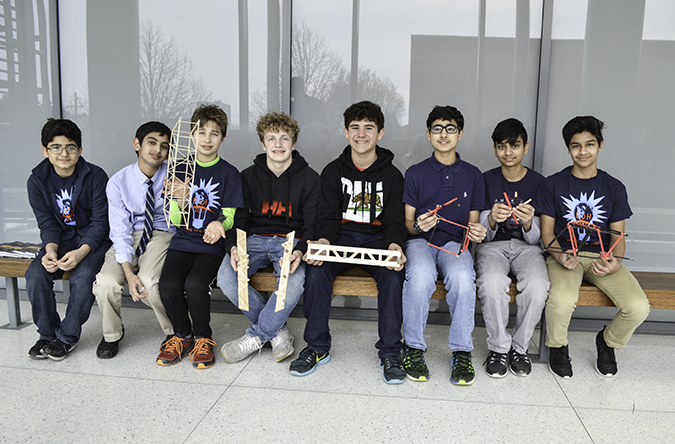
Fritz's eighth graders who participated in the Middle School Design Contest, with the bridges (or remaining pieces) of the bridges they designed for the contest.













.jpg)
















